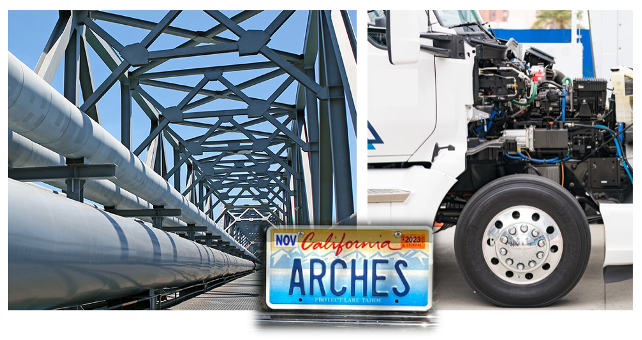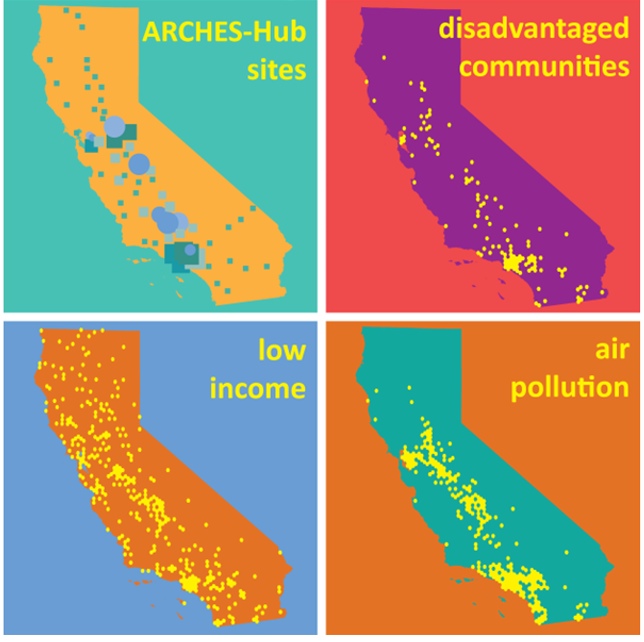California to Build $12 Billion Clean Hydrogen Hub

Nov. 3, 2023 - California is set to build the nation’s largest clean hydrogen ecosystem after the White House recently announced it will award $1.2 billion toward the plan. That figure is only part of a $12 billion hydrogen hub led by the Alliance for Renewable Clean Hydrogen Energy Systems (ARCHES), a public-private partnership, which includes the University of California.
The state will add another $2 billion while industry has committed upwards of $9 billion in over 39 projects that will span eight years. Most of the funds will go to building H2 infrastructure including pipelines, H2 trucks and buses, fueling stations and liquefaction facilities. The new ecosystem is expected to reduce up to two million metric tons of carbon emissions a year and create 220,000 green jobs.
As an intellectual leader in the hydrogen economy, UC Irvine initiated the move to unite the University of California in this unprecedented effort. UCI Chancellor’s Professor of chemical and biomolecular engineering Plamen Atanassov and UCI Chancellor’s Fellow and Professor of mechanical and aerospace engineering Jack Brouwer, director of the Clean Energy Institute, are interim directors for business development on the ARCHES leadership team.
Atanassov is excited to see his vision come to fruition. In November 2021, President Joe Biden signed the Bipartisan Infrastructure Law, which allotted $8 billion for Regional Clean Hydrogen Hubs (H2Hubs). Atanassov envisioned a statewide hub supported by all UC campuses. His plan was later seamlessly integrated with a concurrent vision brewing at Lawrence Berkeley National Laboratory.
Having played a role in the European Union’s hydrogen roadmap, Atanassov recognized the huge opportunity for Irvine to be a national leader in hydrogen ecosystems. Atanassov, Brouwer and many others, including the University of California Office of the President and ARCHES CEO Angelina Galiteva, worked diligently to rally state and local governments, trade unions, industry partners and eventually over 400 partners to join the ARCHES team, which competed against 33 other proposals for the federal funds.
The ARCHES plan will build infrastructure that can transport, store and dispense hydrogen throughout California. A key focus of the plan are ports which will transition to using hydrogen-fueled trucks and cargo handling equipment. The Los Angeles Department of Water and Power will convert a natural gas plant into a hydrogen plant. Aviation, ships and agriculture sectors will also begin to use clean hydrogen.

ARCHES’ projections of areas to benefit from the new hydrogen hub
At least 40% of the benefits of the hydrogen hub will flow to disadvantaged communities, who have been engaged in the proposal development process. These communities are leading an ARCHES working group and are expected to have a seat on the board of directors for ARCHES.
“I’m most excited about improving the air quality near all of the ports and freight corridors of California,” says Brouwer. “This will directly benefit those individuals who are most disadvantaged by diesel combustion emissions that lead to increased cancer risk, asthma, heart disease and premature death in the communities living near ports and freeways."
Starting in 2030, the plan is projected to generate $2.95 billion a year in economic value, including healthcare savings from reduced pollution. California has long led the nation in environmental initiatives and will continue to do so with clean H2. The state aims to achieve carbon neutrality by 2045 and 90% clean electricity by 2035.
Next week, the Department of Energy will meet with the ARCHES Board of Directors to discuss the initial $24 million phase of ARCHES implementation, which is expected to include setting up an ARCHES office at UCI Research Park and hiring staff to manage the hub.
ARCHES also includes the Governor’s Office of Business and Economic Development, the State Building and Construction Trades Council of California and the Renewables 100 Policy Institute.
H2Hubs were also designated in Appalachia (West Virginia and vicinity), Gulf Coast (Texas), Heartland (Minnesota, North Dakota and South Dakota), Mid-Atlantic (Pennsylvania, Delaware and New Jersey), Midwest (Illinois, Indiana and Michigan) and the Pacific Northwest (Washington, Oregon and Montana).
“Next, we’ll connect with other hubs to decarbonize the Western Interconnection - the power grid that includes 14 states,” says Atanassov. It looks like California’s renewable energy leaders are ready to lead the nation toward a net zero emissions world.
- Natalie Tso
